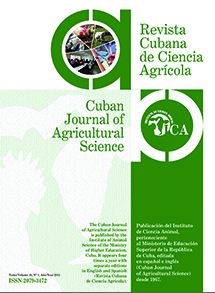Effect of three collections of Tithonia diversifolia on the ruminal microbial population of cattle
Contenido principal del artículo
Resumen
In order to determine the effect of three collections of Tithonia diversifolia (mv-12, mv-14 and mv-17), collected in the eastern region of Cuba, on the ruminal microbial population of cattle, an experiment under in vitro conditions was developed. The control treatments with Cynodon nlemfuensis (star grass) were compared: star grass + mv-12; star grass + mv-14 and star grass + mv-17. The three collections were included at a rate of 20 % of the dry matter. The crude protein content was 19-23 % of the dry matter. With the materials mv-14 and mv-17 higher populations of cellulolytic bacteria were obtained, at three and six hours after starting fermentation with respect to that obtained with star grass. The three collections doubled the population of proteolytic bacteria three hours after starting fermentation, while at six hours only mv-12 produced effects in this bacterial group. The methane values were 37.4, 32.6, 33.2 and 32.33 g/kg of digested organic matter for the control, and the treatments mv-12, mv-14 and mv-17, respectively. Although they did not differ between plant materials, mv-12, mv-14 and mv-17 produced less methane than the star grass treatment only (P = 0.0477). It is concluded that the treatments mv-12, mv-14 and mv-17 caused modifications in the ruminal ecosystem, by increasing the population of total cellulolytic organisms and proteolytic bacteria; in addition to reducing the protozoan population. The methane estimated from crude protein concentration also decreased.
Key words: cellulolytic bacteria, proteolytic, methane, SCFAs, protozoa
Key words: cellulolytic bacteria, proteolytic, methane, SCFAs, protozoa
Detalles del artículo
Cómo citar
Galindo, J., González, N., Ruíz, T., Herrera, M., Moreira, O., Capó, A., & Díaz, H. (2022). Effect of three collections of Tithonia diversifolia on the ruminal microbial population of cattle. Cuban Journal of Agricultural Science, 56(1). Recuperado a partir de https://mail.cjascience.com/index.php/CJAS/article/view/1039
Sección
Ciencia Animal
Aquellos autores/as que tengan publicaciones con esta revista, aceptan los términos siguientes:
- Los autores/as conservarán sus derechos de autor y garantizarán a la revista el derecho de primera publicación de su obra, el cuál estará simultáneamente sujeto a la Licencia Creative Commons Attribution-NonCommercial 4.0 International (CC BY-NC 4.0) que permite a terceros compartir la obra siempre que se indique su autor y su primera publicación esta revista. Bajo esta licencia el autor será libre de:
- Compartir — copiar y redistribuir el material en cualquier medio o formato
- Adaptar — remezclar, transformar y crear a partir del material
- El licenciador no puede revocar estas libertades mientras cumpla con los términos de la licencia
Bajo las siguientes condiciones:
- Reconocimiento — Debe reconocer adecuadamente la autoría, proporcionar un enlace a la licencia e indicar si se han realizado cambios. Puede hacerlo de cualquier manera razonable, pero no de una manera que sugiera que tiene el apoyo del licenciador o lo recibe por el uso que hace.
- NoComercial — No puede utilizar el material para una finalidad comercial.
- No hay restricciones adicionales — No puede aplicar términos legales o medidas tecnológicas que legalmente restrinjan realizar aquello que la licencia permite.
- Los autores/as podrán adoptar otros acuerdos de licencia no exclusiva de distribución de la versión de la obra publicada (p. ej.: depositarla en un archivo telemático institucional o publicarla en un volumen monográfico) siempre que se indique la publicación inicial en esta revista.
- Se permite y recomienda a los autores/as difundir su obra a través de Internet (p. ej.: en archivos telemáticos institucionales o en su página web) antes y durante el proceso de envío, lo cual puede producir intercambios interesantes y aumentar las citas de la obra publicada. (Véase El efecto del acceso abierto).
